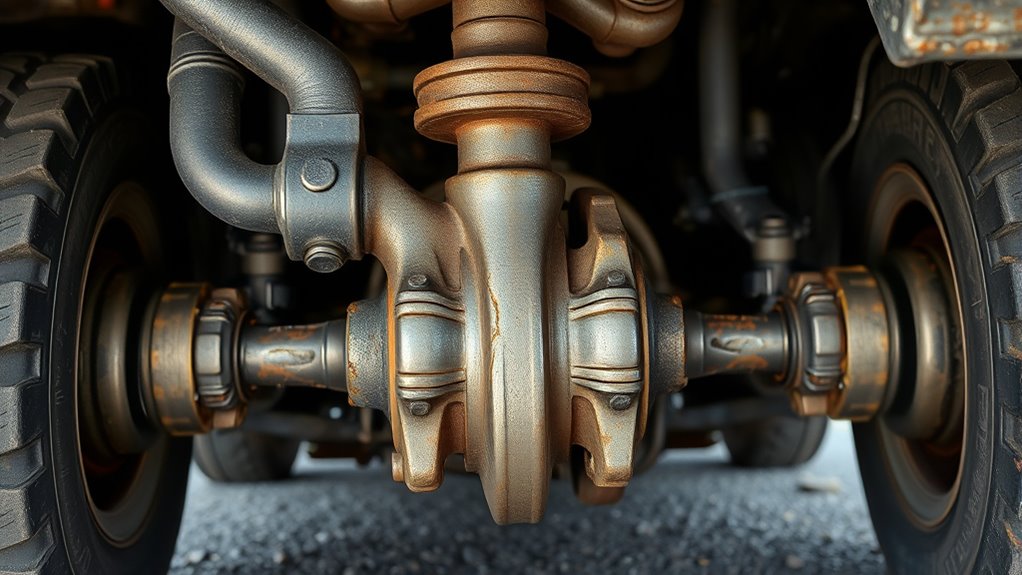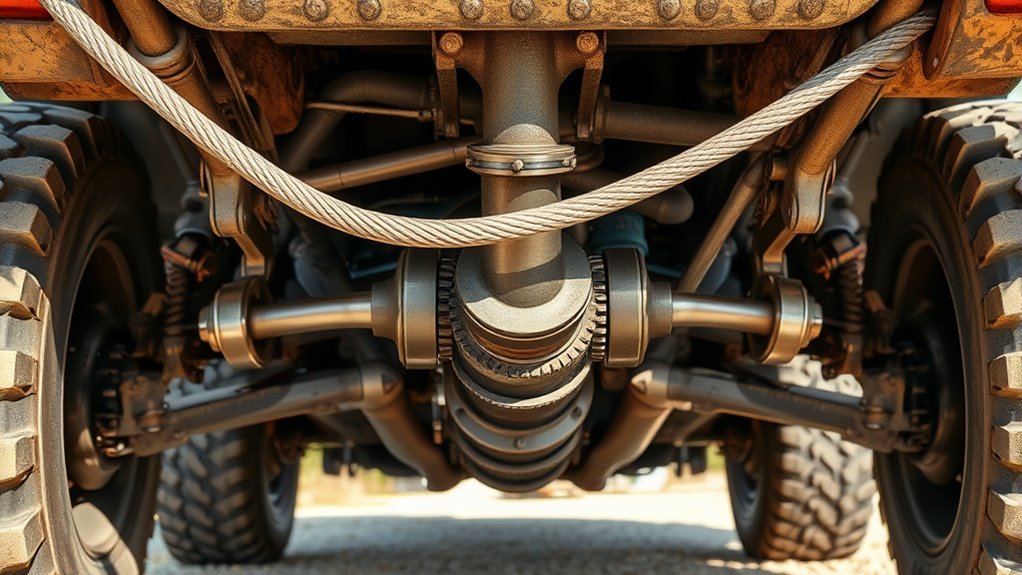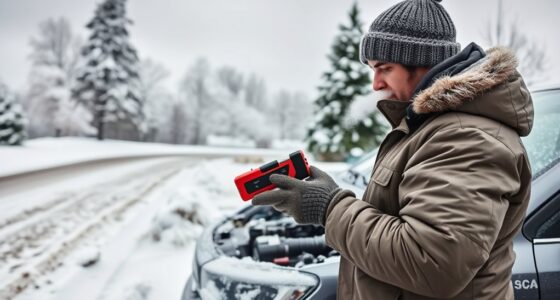Towing puts extra stress on your drivetrain components like the transmission, driveshaft, and differential, causing increased heat and friction. This accelerates wear and can lead to overheating or failure if lubrication isn’t maintained properly. Using the correct gear ratios and keeping fluids fresh helps protect your drivetrain during heavy loads. If you want to learn how to minimize these effects and extend your vehicle’s lifespan, keep exploring for more tips.
Key Takeaways
- Towing places extra stress on transmission, driveshaft, and differential, accelerating wear and potential component failure.
- Heavy loads increase heat and friction, which can degrade lubrication and reduce drivetrain lifespan.
- Proper gear ratios and tow/haul modes optimize power distribution, minimizing drivetrain stress during towing.
- Insufficient or contaminated lubrication leads to overheating, gear seizure, and uneven wear of drivetrain parts.
- Regular maintenance of fluid levels and quality is essential to protect drivetrain components from towing-related damage.

When it comes to towing and drivetrain components, understanding their functions is essential for guaranteeing your vehicle handles heavy loads safely and efficiently. Towing puts extra stress on your drivetrain, especially on parts like the transmission, driveshaft, and differential. To manage this added load, your vehicle relies heavily on the right gear ratios and proper drivetrain lubrication. Gear ratios determine how power is transmitted from the engine to the wheels, affecting torque and speed. When towing, you often need lower gear ratios, which increase torque and provide better control over heavy loads. This is why many vehicles have tow/haul modes—these shift to gear ratios optimized for towing, reducing strain on the drivetrain and helping prevent overheating or premature wear.
Drivetrain lubrication plays a crucial role in maintaining the health of these components. Heavy towing causes increased heat and friction, which can accelerate wear if the lubrication isn’t sufficient or becomes contaminated. Proper lubrication ensures that gears, bearings, and other moving parts operate smoothly and stay cool under stress. Regularly checking and changing transmission fluid, differential oil, and transfer case lubricant becomes even more critical when you tow frequently or over long distances. Failing to maintain proper lubrication can lead to increased friction, overheating, and eventual component failure, resulting in costly repairs and downtime.
Towing also influences how your drivetrain components distribute power. When pulling a heavy load, your vehicle’s transmission must work harder, which can lead to higher stress on the gears and bearings. If your gear ratios aren’t suited for towing, you may notice sluggish acceleration or increased engine strain. Additionally, improper or neglected drivetrain lubrication can cause gears to seize or wear unevenly, compromising overall performance. To mitigate these issues, ensure your drivetrain fluid levels are adequate and that the fluids are fresh. Using the recommended type and viscosity of lubricant helps maintain ideal protection and performance, especially under the added pressure of towing.
Moreover, selecting the right wheatgrass juice can support your overall energy and recovery, which is beneficial when towing heavy loads. Furthermore, frequent towing can accelerate the degradation of drivetrain components if not properly managed. Over time, the combination of high torque, heat, and friction wears down parts like clutch packs, gears, and seals. This makes it even more important to pay close attention to gear ratios—making sure they’re appropriate for your towing needs—and to keep drivetrain lubrication at peak condition. By doing so, you’ll prolong the lifespan of your drivetrain, ensure safer towing experiences, and avoid unexpected breakdowns. Proper maintenance and understanding these fundamental factors enable you to tow confidently, knowing your vehicle’s drivetrain remains protected under heavy loads.
Frequently Asked Questions
How Often Should I Inspect My Drivetrain After Towing?
You should inspect your drivetrain after every few towing sessions, especially if you tow frequently or heavy loads. Follow a regular inspection schedule, ideally every 3,000 to 5,000 miles, or more often if you notice unusual noises or vibrations. Regular checks help catch wear or damage early, ensuring your drivetrain stays in good shape and prolongs its lifespan. Always consult your vehicle’s manual for specific towing and inspection guidelines.
Can Towing Damage Specific Drivetrain Parts More Than Others?
Yes, towing can damage specific drivetrain parts more than others, especially the transfer case and axle shafts. If you tow improperly or exceed weight limits, the transfer case can suffer from increased wear or fluid leaks, while axle shafts might experience excessive stress, leading to bending or breakage. Regular inspections and proper towing techniques help prevent damage to these critical components, ensuring your drivetrain stays in good shape.
What Signs Indicate Drivetrain Issues Caused by Towing?
Imagine your drivetrain as a well-oiled machine struggling under extra weight. Signs of towing-related issues include difficulty shifting gears, strange noises like whining or grinding, and fluid leaks. If you notice these, check your drivetrain lubrication and make certain you’re staying within towing weight limits. Ignoring these signs can lead to costly repairs, so stay attentive to how your vehicle responds after towing heavy loads.
Does Towing With a Manual or Automatic Transmission Affect Drivetrain Wear Differently?
Towing with a manual transmission can put more strain on your drivetrain, especially if you’re not shifting properly or exceeding the gear ratio limits. Automatic transmissions generally handle towing better, but they still experience wear if you frequently tow near your vehicle’s towing capacity. Both types influence drivetrain components differently, so always stay within your vehicle’s recommended towing capacity to minimize wear and extend component life.
Are There Towing Practices That Can Minimize Drivetrain Damage?
A stitch in time saves nine, so follow proper towing practices to protect your drivetrain. Always guarantee your hitch setup is correct, preventing unnecessary stress on components. Stick to recommended towing speed limits to reduce strain and overheating. Distributing weight evenly and avoiding sudden stops also help minimize drivetrain damage. By being cautious and following these tips, you’ll keep your vehicle’s drivetrain healthier longer and avoid costly repairs.
Conclusion
Don’t let the fear of added wear keep you from towing when needed. Proper maintenance and understanding how towing impacts your drivetrain can prevent costly repairs and keep you safe on the road. Remember, taking care of your vehicle isn’t just about avoiding expenses; it’s about ensuring your journeys are smooth and worry-free. With the right precautions, you can tow confidently, knowing your drivetrain components are protected and ready for every adventure ahead.









